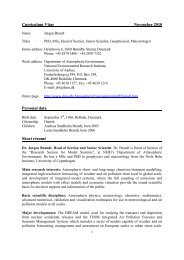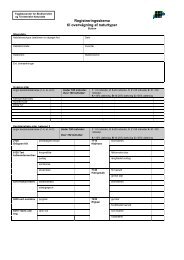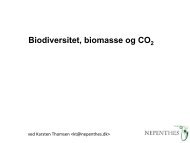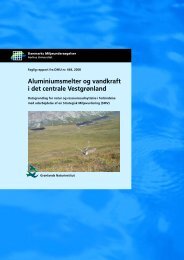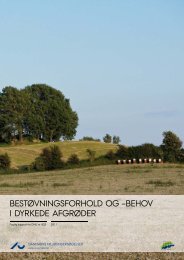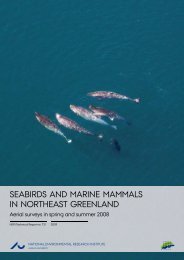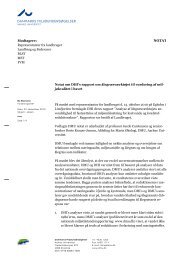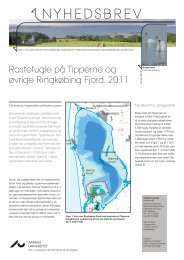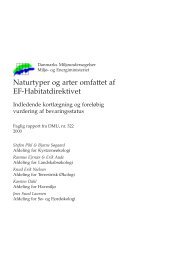Spatial distribution of emissions to air - the SPREAD model
Spatial distribution of emissions to air - the SPREAD model
Spatial distribution of emissions to air - the SPREAD model
You also want an ePaper? Increase the reach of your titles
YUMPU automatically turns print PDFs into web optimized ePapers that Google loves.
42<br />
set up for future use. Emissions <strong>of</strong> NH3 from NH3 treated straw are allocated<br />
<strong>to</strong> conventional d<strong>air</strong>y cattle farms excluding a minor number <strong>of</strong><br />
suckling cattle farms that might use NH3 treated straw.<br />
&URS UHVLGXH<br />
Input data for calculation <strong>of</strong> N2O <strong>emissions</strong> from crop residue is available<br />
in <strong>the</strong> GLR register, which include crop types on field level and<br />
from <strong>the</strong> LPIS data due <strong>to</strong> location <strong>of</strong> <strong>the</strong> fields.<br />
1 IL[LQJ FURSV<br />
Calculation <strong>of</strong> N2O <strong>emissions</strong> from N-fixing crops are based on data<br />
from <strong>the</strong> GLR register on crop types on field level and from <strong>the</strong> LPIS<br />
data where <strong>the</strong> location <strong>of</strong> <strong>the</strong> relevant fields are available.<br />
+LVWRVROV<br />
Distribution <strong>of</strong> N2O from his<strong>to</strong>sols is based on <strong>the</strong> LPIS data in combination<br />
with a map <strong>of</strong> organic soils in <strong>the</strong> soil map based on <strong>the</strong> Danish soil<br />
classification. The emission is distributed evenly on <strong>the</strong> area identified<br />
by intersection <strong>of</strong> <strong>the</strong> field area and <strong>the</strong> organic soil area.<br />
/HDFKLQJ<br />
When <strong>the</strong> fields are fertilised part <strong>of</strong> <strong>the</strong> applied N is not assimilated by<br />
<strong>the</strong> crops. The surplus cause leaching and run-<strong>of</strong>f, which again leads <strong>to</strong><br />
emission <strong>of</strong> N2O. The emission calculations are based on N-content <strong>of</strong> <strong>the</strong><br />
applied fertiliser, manure and sludge. The spatial <strong>distribution</strong> is based<br />
on <strong>the</strong> recommended application rate for each crop from <strong>the</strong> GLR database<br />
in combination with LPIS data. The leaching fac<strong>to</strong>r is assumed <strong>to</strong> be<br />
independent <strong>of</strong> soil type.<br />
$WPRVSKHULF GHSRVLWLRQ<br />
The <strong>distribution</strong> key for emission <strong>of</strong> N2O from NH3 evaporation is estimated<br />
as a sum <strong>of</strong> NH3 from point sources and area sources covering<br />
manure and mineral fertiliser application. This approach is subject <strong>to</strong><br />
some degree <strong>of</strong> inaccuracy as <strong>the</strong> emission <strong>of</strong> N2O takes place at <strong>the</strong> site<br />
for deposition <strong>of</strong> NH3 and not at <strong>the</strong> site for evaporation <strong>of</strong> NH3 as given<br />
in <strong>the</strong> <strong>distribution</strong> key. Introduction <strong>of</strong> a transport <strong>model</strong> <strong>to</strong> make a<br />
deposition map would improve <strong>the</strong> <strong>distribution</strong> key. This has not been<br />
included in <strong>SPREAD</strong>, as <strong>the</strong> available deposition maps include longrange<br />
transboundary NH3, which is not <strong>to</strong> be included in <strong>the</strong> Danish<br />
emission inven<strong>to</strong>ry. Fur<strong>the</strong>r, NH3 from agriculture is not transported<br />
very far before deposition and <strong>the</strong>refore <strong>the</strong> inaccuracy is assumed <strong>to</strong> be<br />
<strong>of</strong> little importance for <strong>the</strong> allocation <strong>of</strong> <strong>the</strong> <strong>emissions</strong>.<br />
All NH3 <strong>emissions</strong> from <strong>the</strong> Danish terri<strong>to</strong>ry are included in <strong>the</strong> <strong>emissions</strong><br />
<strong>distribution</strong> although studies have shown that only part <strong>of</strong> <strong>the</strong><br />
Danish ammonia emission is deposited on <strong>the</strong> Danish area. The Danish<br />
share <strong>of</strong> <strong>the</strong> NH3 deposition on Danish land area is around 36 % and <strong>the</strong><br />
corresponding share for <strong>the</strong> Danish sea area is 14 % (Ellermann et al.<br />
2010.





